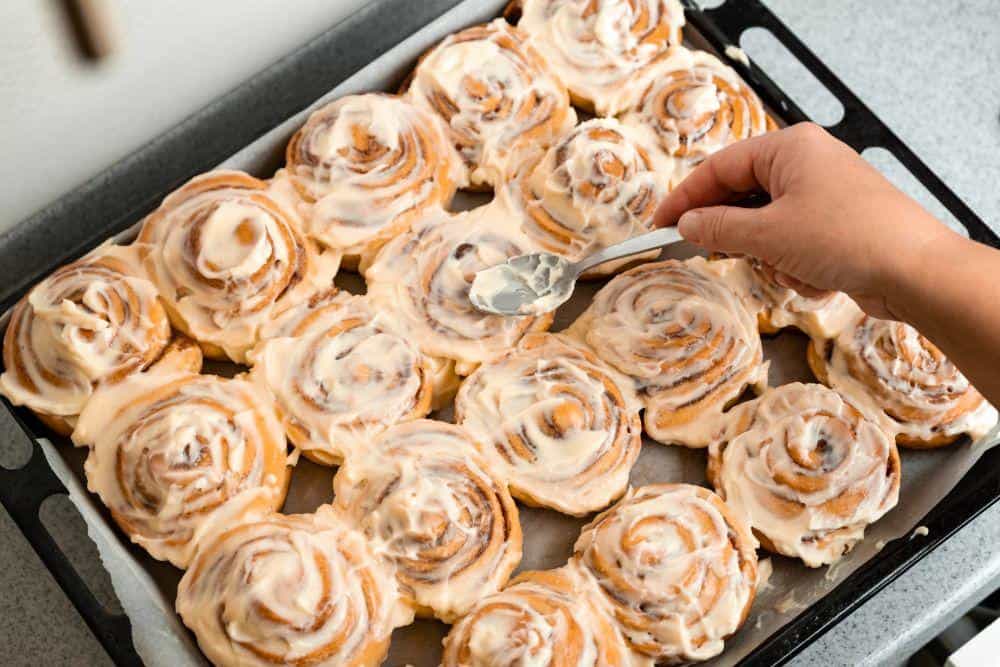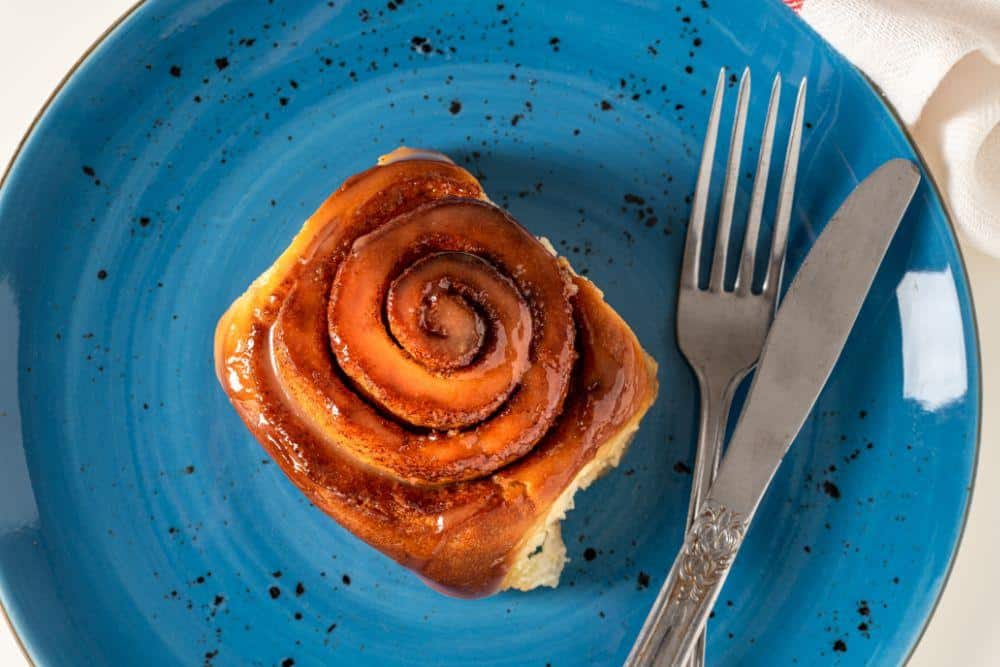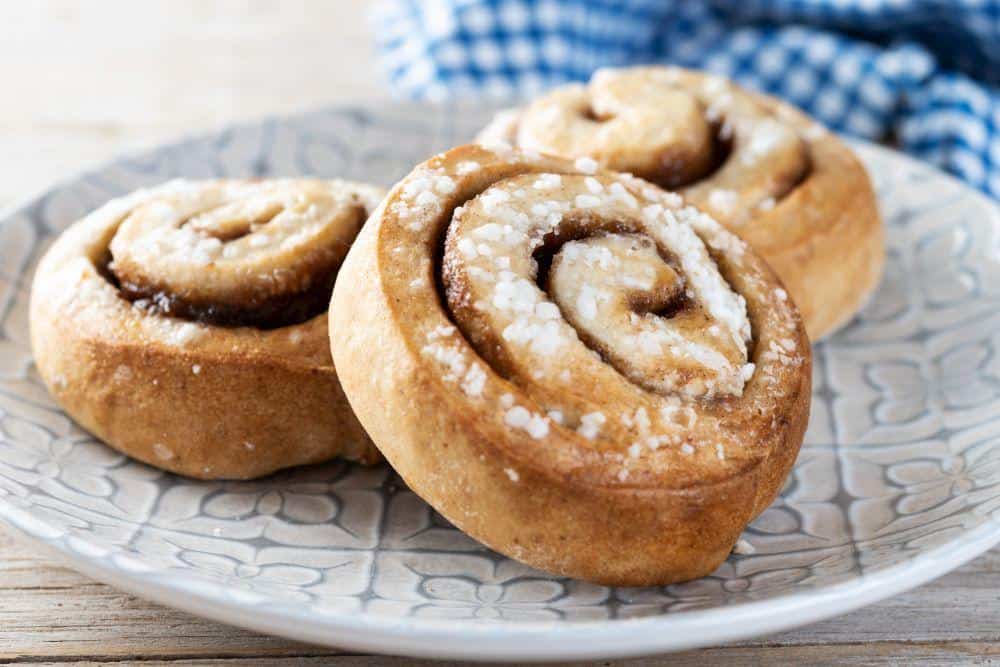One of the main issues people face when preparing fresh-yeast cinnamon rolls is that it takes ages to prepare. For that reason, most people consider preparing the dough the night before.
But is it safe to leave cinnamon roll dough out overnight? Should you leave it on the kitchen counter? Should you refrigerate it?
Let’s dive in and get all the answers.
Cinnamon roll dough can be left overnight if refrigerated and for 12 - 24 hours. You can refrigerate it after kneading or before the first rise. It’s possible to store it even after it has risen and shaped as desired. The most crucial thing to remember is that the dough should be kept in a tightly sealed container or bowl before refrigerating.
You may wonder what happens if you leave the cinnamon roll dough out overnight at room temperature. The problem with leaving the dough at room temperature is that it will double its size within 2-4 hours.
Therefore, leaving the dough overnight will make it collapse, leaving it deflated. The weight of the dough will be too heavy, which is why it will likely collapse after some time. For optimal results, it’s advisable to refrigerate the cinnamon roll dough and let it rise overnight.

Refrigerated Dough Creates the Best Cinnamon Rolls
You shouldn’t let the dough rise for too long, especially if it’s at room temperature. Allowing the dough to rise for too long affects the texture and the taste of the finished bread.
You should realize that the dough ferments while it rises. Therefore, if you let the dough ferment for too long, it will make the bread taste sour. If you don’t plan on refrigerating your cinnamon dough, then you should only leave it on the kitchen counter to sit for a maximum of four hours. It’s worth noting that the temperature, sugar characteristics in the flour, room’s humidity, and amount of yeast affect the length of the rise.
Leaving the cinnamon roll dough to rise overnight has benefits since it allows for slow fermentation, giving your bread a yummy taste. Refrigerating your dough also gives you time to bake the bread at your convenient time. After refrigerating the dough, you may wonder whether you should bring it to room temperature before baking.
The good news is that it’s safe to bake cold bread dough. You don’t have to bring the cinnamon roll dough to room temperature. The dough will still bake evenly even if it’s baked cold.
So, how should you bake bread dough straight from the fridge?
For the best results, consider leaving the cinnamon roll dough at room temperature for the first rise. Refrigerate it for the final proof. If you have time during the day, prepare dry yeast or a starter. After that, knead the dough in the evening, and let it sit at room temperature for the first rise. Shape the dough later and place it in a proofing container to refrigerate overnight. The roll dough will be ready for baking in the morning.
Before you bake the dough, preheat the oven for about 30 minutes. Ensure the dough isn’t removed from the fridge too early since this could lead to over-fermenting, especially if it had stayed in the fridge for too long. Don’t let the dough sit for more than 30 minutes once it’s out of the refrigerator.
Uncooked cinnamon rolls can last for up to 24 hours when refrigerated. Refrigerating them longer could make the filling liquify and pour out of the rolls. But this rarely happens, so it’s nothing to worry about.
The best way to store uncooked rolls is to wrap them individually, place them in an airtight container, and freeze them. Allow the rolls to thaw in the fridge for six hours when you want to bake them. Be careful not to let the rolls thaw at room temperature because this might make them over-ferment.
If you’ve already baked the cinnamon rolls and want to store them, keeping them at room temperature for up to 3 days is safe. It’s best to cover the rolls using tin foil. To quickly warm your homemade cinnamon roll, spread butter on each roll and microwave for a minute.

Leaving Dough Out for too Long Can Affect the Quality of Your Cinnamon Rolls
You may be curious whether you can freeze unbaked cinnamon rolls for long. You can freeze the cinnamon rolls for up to eight weeks. While there’s nothing wrong with freezing baked rolls, it’s advisable to freeze them uncooked. Freezing them and baking only when you’re ready allows you to enjoy the fresh taste of your cinnamon bun.
So, how should you ensure that you freeze the unbaked rolls for the best results? Freezing your cinnamon rolls might be tricky because you must confirm that you do it at the right stage. The goal is to freeze them just after giving the rolls some time to rise. Doing this guarantees you can bake them and still have a fresh taste. To achieve this, follow the following steps:
Pop the rolls in a freezer and label them. Labeling helps to make sure you don’t leave the rolls to sit longer than required.
Once you’ve frozen your cinnamon rolls and baked them, you shouldn’t refreeze them again. The quality of your cinnamon buns won’t be the same. You risk spoiling the taste and texture of the bread by refreezing.
To avoid this, take out only the rolls you can bake and finish eating. If you can’t finish the baked cinnamon rolls, consider carrying them to your office and sharing with your colleagues or sharing some with your neighbor.
The physical properties of the dough will tell you whether the dough has gone bad or not. For instance, if the dough was refrigerated and the texture is dry or diminished with a crusty appearance, this indicates that it may have gone bad. If the dough has a gray color instead of beige or a fresh white, this is another sign that it’s likely spoiled.
Dough stored in the freezer with freezer burns like visible freezer crystals or whitish spots is also a bad sign. Sure, baking your cinnamon buns with freezer burns won’t make your stomach rumble, but it won’t give you a desirable taste, and the dough might not bake evenly. So, if you notice these signs, you need to throw the dough in the bin.
Labeling your cinnamon rolls when freezing them helps to ensure you don’t let them sit for too long in the freezer.

Freeze Leftover Dough for Later Use
If you’ve been baking or will bake cinnamon rolls, you probably have some other questions popping in your head. Let’s try to answer those so that you’re able to make the perfect cinnamon rolls for your family and friends to enjoy. And you of course!
You should use bottom heat. This will insure that the center is fully cooked and the top gets that light golden brown color.
It might be worth it depending on what brings you satisfaction. Baking them at home allows you to control the portions and the ingredients, and you’ll feel the satisfaction of eating something fresh made by you. Or you might not have any other way of have access to cinnamon rolls.
If it’s not important for you to eat something you made, or if it’s not your favorite treat, it might not be worth it. Baking always takes time and some work.
You should place the cinnamon rolls together because this way the sides won’t become hard from the heat. The sides will stay fluffy and moist.
